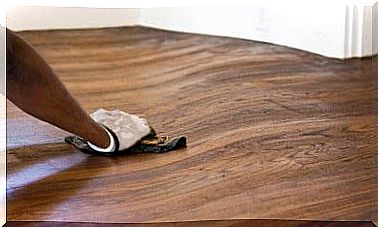Stretching Exercises To Do Before Going To Bed

We’re going to talk about seven stretching exercises you can do before bed. Many people have sleeping problems and this deteriorates their quality of life in the short term. Sleeping is intended to achieve optimal rest that encourages the body to regenerate. Overall, it should lead to a more fulfilling life.
These stretching exercises are usually for people who build up daily tension and who experience back, leg or neck pain when they wake up. The best thing about these stretches is that they also help reduce your stress levels from the first day you practice them.
Stretching exercises before going to bed

It may seem counterproductive to stretch before going to bed. However, it is ideal for your joints and muscles, which in turn prevents you from waking up in pain due to certain bad postures you adopt during the night.
It’s not necessarily an exercise routine, but it’s mainly about gently stretching your body through stretching exercises.
1. Forward Bend
The spine, lower back, and hamstrings are all involved when you bend forward. You will see how much more relaxed you will be after doing this stretching exercise. It will also improve your sleep quality. Here’s how to do it:
- Sit down and stretch your legs.
- Then extend your arms until you reach and touch the tips of your toes (if possible).
- Put your chin against your chest and try not to put any tension on the head or neck area.
- Hold this pose for as long as possible, up to five minutes (take it easy at the beginning).
2. Legs against the wall
According to a group of specialists at Vicario Clinics (Spanish link), placing your legs against the wall is one of the best stretches you can do before going to bed. It promotes the drainage of fluids and good blood circulation. Here’s how to do it the right way:
- Place your legs high against the wall.
- Your hips may touch the wall or be a few inches away from it. Do what is comfortable for you.
- Also bring your arms and back into a comfortable position.
- Finally, bend your feet toward you.
- Hold this pose for 10 minutes to maximize the benefits.
3. The Child Attitude
Yoga is also good to do before going to bed. Especially the child’s attitude can help. This pose helps you to synchronize your breathing, relax your body and reduce stress. It is perfect for beginners who want to improve their sleep:
- First, get on your knees with your face down, as if you were going to sit with your buttocks on your heels.
- Rest your forehead on the floor and stretch your arms forward as far as possible.
- It is essential to focus on your breathing. It should be a deep breath in this stretching exercise.
- Hold this pose for 5 minutes or as long as you can.
4. Landscape maximum angle
This position is great for beginners because it doesn’t require a lot of agility. The benefit of doing this before going to bed is that it helps your legs relax. This is especially helpful after a day of walking and standing. This is how you do this exercise:
- Lie on your back on the floor and try to keep your back straight against the floor.
- Then bring the soles of your feet together and bend your knees slightly.
- The trick to this pose is to spread your knees apart so that the weight of your thighs promotes stretching of the groin, relaxing the entire area.
- Hold the pose for 30 seconds while taking a deep breath, focusing on relaxing as much as possible.
5. The number 4 stretch
Kirsty Godso, a Zen trainer, recommends this position to relax the muscles of the legs and arms while strengthening them. Below is the step-by-step guide on how to do this. It’s actually quite easy to do, so add it to your stretching routine before going to bed.
- Lie on your back on a bed or couch, with your arms bent.
- One of your feet should rest on the other leg (hence the name ‘number 4’, as it looks like a 4).
- The ultimate idea is to lower and stretch the hip muscles, especially the piriformis or pear-shaped muscle.
6. Stretching the Dorsal Muscle
The dorsals are the largest and strongest muscle group in your torso. Stretch them before going to sleep to relax them. They are often exhausted in people who use their upper body for work. Do it like this:
- Extend your arms as far as you can when sitting on the couch or the edge of your bed.
- Rest your feet on the floor and try to keep your back straight, the same way you keep your arms straight.
- Hold the pose for 20 to 30 seconds, focusing on controlled breathing.
- It is important to work on your technique. It’s about relaxing your muscles and getting a good rest. It won’t work if you don’t do it right.
7. Frog Pose
This is indeed a strange name for a pose, but the frog pose or frog pose is very good for relaxing the groin and hips. There are several ways to do it. However, we think the option we recommend here is the most ideal:
- Place your knees on the floor, spreading them apart until you feel the muscles in your groin and hips tighten.
- Lean on your elbows and clasp your hands together for more pressure.
- Your feet should be pointing outwards and always focus on good breathing.
- Hold the pose for a minute.
Stretching exercises to do before going to bed

According to the group of specialists at TerapiaCPAP (Spanish link), stretching before going to bed will help you rest better. In addition, they can relieve back pain and release muscle tension.
Note that these stretches are not really a tired routine to fall asleep faster. This is relaxation therapy to help you achieve a restorative night’s sleep. In addition, you will wake up without muscle pain.
Do these exercises slowly and focus on deep breathing. You should not feel any pain doing these stretching exercises. So move your body smoothly until you have reached the desired position. You’ll see how quickly they reduce the factors that affect your sleep quality.









